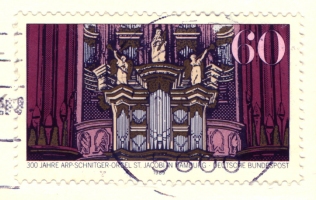

Seventeenth Century Germany
|
| Dispositions and Tonal Characteristics | Photographs | Review Quiz |
IntroductionMost scholars and scholarly organists agree that the most important organ builder of northern Germany during the seventeenth century was Arp Schnitger. Schnitger, who spelled his name in various ways at different times of his life, lived from 1648 until 1719 and was active in both the Netherlands and in northern Germany as an independent builder working from the 1680's until his death. Several of his instruments survive to this day, although most of them have been altered to one extent or another in the centuries they have been in use. He or members of his workshop staff are known to have worked on over 150 organs, either rebuilding earlier instruments or building completely new ones. His instruments were played by leading organists, his work was well-known throughout Europe, and his business conduct was directed by high ethical and moral standards.145 It is not correct, however, to assume that his organs were built according to a single pattern, that they all sounded alike, or that instruments not built by Schnitger are somehow less important than his. Just as the seventeenth century saw many different types of organs built in Germany, so were there different builders. Even Schnitger used different approaches at different times, in part because buildings and materials presented different musical needs, in part because throughout his lifetime he adapted to the needs around him. In short, his life, his attitude toward his work, and his surviving instruments attest to his position not merely as an organ builder, but as an artist who made musical instruments.
|
| Top of Page | Dispositions and Tonal Characteristics | Photographs | Review Quiz |
Dispositions and Tonal CharacteristicsThe instruments of Schnitger are examples Werkprinzip organs, to use a twentieth-century term in common use today.152 Even though you might even consider his instruments to have defined the type, they are not all alike. In many cases, Schnitger was reworking and/or enlarging older instruments, not building new ones. If he found good pipework that could be reused, he did so, so the details may vary from one instrument to another because of what he found on site when he started a job. Additionally, he built organs of different sizes for many different buildings. Some of the organs are small, including about a dozen two-manual instruments of only a few stops and no independent pedal division. Others were very large, like the one for St. Johanniskirche in Magdeburg, which had 60 stops (including two 16' Principals and a 32' Posaune) on four manuals and pedal. Details of some of his instruments are given on separate pages of this tutorial. In spite of the great range in size of his instruments, and in spite of the range of original and recycled materials he used in his work, there are some things that can be said about the dispositions of his organs.
|
| Top of Page | Dispositions and Tonal Characteristics | Photographs | Review Quiz |
|
PhotographsYou can see an enlargement of the photograph at the head of this page. You will have to use your browser's "back" button to return to this page.
|